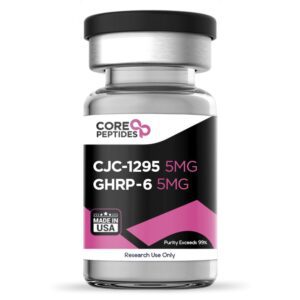Description
ACE-031 Peptide (ActRIIB-IgG1 Peptide)
Overview
ACE-031, also known as ActRIIB-IgG1 peptide, is a soluble fusion protein designed to function as a myostatin inhibitor. Structurally, it consists of the extracellular domain of the activin receptor type IIB (ActRIIB) fused to a recombinant immunoglobulin IgG1 Fc fragment. This design allows ACE-031 to bind circulating ligands of the TGF-β superfamily, most notably myostatin (GDF8), thereby preventing them from inhibiting the native ActRIIB receptors in skeletal muscle. By blocking myostatin signaling, ACE-031 is posited to promote muscle hypertrophy, increased skeletal muscle mass, and enhanced metabolic function.
Myostatin, discovered in 1997, is a negative regulator of skeletal muscle growth. It binds ActRIIB receptors, triggering the Smad2/3 signaling cascade that suppresses muscle cell proliferation and differentiation. Myostatin is primarily expressed in skeletal muscle and has little effect on cardiac or smooth muscle. ACE-031’s inhibition of circulating myostatin allows the activation of muscle growth pathways, with potential secondary effects on fat metabolism, bone density, and overall muscle function.
Chemical Properties
-
Molecular Formula: C3418H5188N928O1062S38
-
Molecular Weight: 77,489.82 g/mol
-
Other Names: Soluble activin type IIB receptor, ActRIIB-IgG1-Fc
Mechanism of Action
ACE-031 functions by binding circulating myostatin and other TGF-β ligands, preventing them from activating ActRIIB receptors in skeletal muscle. This inhibition allows:
-
Activation of satellite cells and hypertrophy pathways.
-
Increased skeletal muscle mass and volume.
-
Modulation of fat metabolism and potential reduction of adipose tissue.
-
Potential effects on bone formation and remodeling.
The peptide’s long half-life (10–15 days) supports sustained receptor blockade, making it effective for intermittent dosing in experimental and clinical research settings.
Research and Clinical Applications
1. Muscle Hypertrophy
In a double-blind, placebo-controlled study, healthy volunteers treated with ACE-031 demonstrated:
-
3.3% increase in total body lean mass (DEXA, P = 0.03)
-
5.1% increase in quadriceps muscle volume (MRI, P = 0.03)
These findings suggest that ACE-031 can induce muscle hypertrophy by inhibiting myostatin and activating muscle growth pathways. Serum biomarkers also indicated potential improvements in bone and fat metabolism.
2. Fat Metabolism
Animal studies indicate that myostatin is upregulated in obesity, contributing to decreased muscle mass and increased fat accumulation. ACE-031 has been observed to:
-
Increase fatty acid oxidation by upregulating enzymes such as CPT1a and CPT2.
-
Promote brown (beige) fat formation, enhancing thermogenesis.
-
Reduce fat accumulation in high-fat diet murine models.
These effects highlight ACE-031’s potential role in modulating body composition and mitigating obesity-related phenotypes.
3. Muscle Contractile Force
ACE-031 may enhance muscle functional capacity by:
-
Increasing muscle volume by up to 33% in murine models without altering fiber-type distribution.
-
Raising basal oxygen consumption (+22%) and energy expenditure (+23%).
-
Improving maximum and total absolute contractile force (40% and 24%, respectively).
This suggests a potential benefit in muscle performance and endurance, although fatigue resistance and specific metabolic pathways may remain unchanged.
4. Bone Density
ACE-031 has shown potential osteogenic effects in murine models of Duchenne Muscular Dystrophy (DMD):
-
Increased femoral bone volume (+80%) and trabecular number (+70%).
-
Improved vertebral bone mass (+20–30%).
-
Reduced osteoclast numbers and increased expression of osteoblast markers.
-
Enhanced bone strength and stiffness in biomechanical testing.
These findings indicate a potential dual role in muscle and bone health, particularly relevant in conditions of muscle wasting or osteoporosis.
Conclusion
ACE-031 is a myostatin-inhibiting fusion peptide with demonstrated potential to increase skeletal muscle mass, enhance fat metabolism, improve muscle contractility, and promote bone formation. It is an important tool for research into muscle-wasting disorders, metabolic syndrome, and musculoskeletal health.
ACE-031 peptide is intended for research and laboratory use only. Adherence to safety protocols and regulatory guidelines is required.
References
-
Campbell C, et al. “Myostatin inhibitor ACE-031 treatment of ambulatory boys with Duchenne muscular dystrophy: Results of a randomized, placebo-controlled clinical trial.” Muscle Nerve. 2017;55(4):458-464.
-
McPherron AC, Lawler AM, Lee SJ. “Regulation of skeletal muscle mass in mice by a new TGF-beta superfamily member.” Nature. 1997;387:83-90.
-
Attie KM, et al. “A single ascending-dose study of muscle regulator ACE-031 in healthy volunteers.” Muscle Nerve. 2013;47(3):416-423.
-
Yang M, et al. “Myostatin: a potential therapeutic target for metabolic syndrome.” Front Endocrinol (Lausanne). 2023;14:1181913.
-
Zhang C, et al. “Inhibition of myostatin protects against diet-induced obesity in mice.” Diabetologia. 2012;55:183-193.
-
Béchir N, et al. “ActRIIB blockade increases force-generating capacity and preserves energy supply in exercising mdx mouse muscle in vivo.” FASEB J. 2016;30(10):3551-3562.
-
Puolakkainen T, et al. “Treatment with soluble activin type IIB-receptor improves bone mass and strength in a mouse model of Duchenne muscular dystrophy.” BMC Musculoskelet Disord. 2017;18:20.





Reviews
There are no reviews yet.